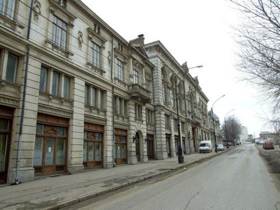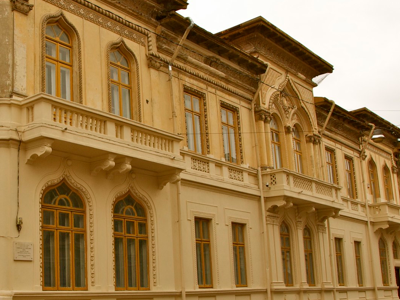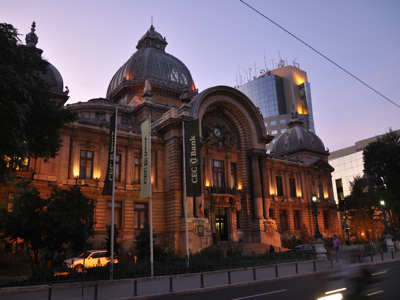The palaces described hereunder do not host museums, but different public institutions or private businesses. Some can be visited when there is an art exhibition or a cultural event there, others have public areas, while there are still some no access ones, but one can always admire the building from the outside. I have listed them in a North - South order, so that one can start in Piața Victoriei (subway station and bus stops provided) and slowly come down towards the Palace of the Parliament, a good share of detours to the left and right included.
Constantin Bebe Brătianu Palace. The building (see the top left picture for the Visarion Street facade) was raised following Architect Ion Socolescu’s plans as a family residence in 1896 and it was later owned by the Creditul Urban, a local banking business. Together with his sister, Constantin Bebe Brătianu bought the building in 1924. He was coming from a family of local politicians, ministers and founders of the National Liberal Party. The property initially stretched all the way to Lascăr Catargiu Avenue, but a part of the yard was sold off and a relatively tall apartment building was raised there in the interwar period. The palace saw the typical saga of the early days of Communist Romania: while two of the Brătianus died in the new regime’s political prisons (Dinu Brătianu, in 1947 and Gheorghe Brătianu, in 1953, both in Sighet Prison), the palace was nationalized. It then hosted the office of a local Communist Party Committee, a government culture and art office and eventually a medical unit. Returned to the inheritors of the Brătianus, it nowadays hosts Ion I. Brătianu Foundation, with cultural events being held there and a permanent exhibition of the family paintings.
The building has features belonging to different styles, but Oriental patterns (especially at the window frames), arabesques and Venetian decorations prevail. Several elements manage to preserve the bygone bourgeois grandeur of the building, such as the red and green marble stairway, the stucco ceilings bearing stylized calligraphic and vegetal patterns, the Meissen porcelain stoves, the skylight above the first floor hallway, the partly preserved parquet floors. While the building is not very well preserved and a thorough restoration is required, it is well worth a visit. The palace lies on 4-6 Visarion Street, at a 5 minute walk from Piața Romană subway station. GPS - N44 26.841 E26 05.687
Barbu Știrbei Palace. The palace was raised by Voyevode Barbu Știrbei and it has a facade featuring many classical Greek elements. It was raised between 1833-1835, following the plans designed by Architect Michel Sanjouand. It was restored and a new wind was added in 1881; a tower was also added during the process. The building used to host the Museum of Porcelain and Glass (until 1990).
There is a project to restore it, but at the price of adding a tall glass covered, concrete block to its back. There is much ado around the project at the time being, traditional Romanian corruption in the City Hall Urbanism Office and Ministry of Culture included. GPS - N44 26.633 E26 05.530
Crețulescu Palace. Coming from a family of rich boyars, Elena Crețulescu inherited a couple of houses from her father and she turned them in the actual palace in 1902. Perfectly adapted to the nature that surrounds it, the palace is set in Romantic style with decorative elements belonging to the French Renaissance style. The facade to the back, towards the park, is remarkable through its tower and the monumental exterior stairs. A great nature lover, Elena Crețulescu built a garden full of statues and fountains around the palace, garden which was incorporated in the Cișmigiu later on. The owner also built a greenhouse in the right wing of the palace. The palace was sold to the City Hall before 1930 and it hosted the Museum of Religious Art until 1948. Nowadays it hosts the UNESCO European Centre for Higher Studies. And the guards are not so keen of people taking pictures of it. Maybe this is a new UNESCO rule.
GPS - N44 26.377 E26 05.327
The City Hall. After 1882, the City Hall was hosted by the 1810 Hagi Moscu House that used to lie in front of the actual National Theatre. As the building was too small and improper for its new function, being demolished in 1912, a palace meant to host the City Hall was envisaged three times, once in 1895-1896 (when the project contest was won by Ion Mincu), in 1913 (when Petre Antonescu’s project was chosen) and again in 1935-1936, with Antonescu winning again, yet in vain, given the start of WW2.
The building we are looking at today used to host the Ministry of Public Works. It was built between 1906-1910, after the plans drawn by the same architect, Petre Antonescu. During the WW1 German occupation of 1916-1918, it hosted the General Headquarters of the German Army. Back in use by the Romanian Government in the interwar period, the building was damaged by the WW2 bombings and it was restored in 1948, hosting afterwards the City Hall which still had no suitable headquarters. Given the fact that the 1910 palace required restoration works, 2010 saw the institution moving away in a steel and glass block on 291-293 Splaiul Independenței, while they are undergoing restoration works here. Even so however, you can always have a look at the building exteriors. This is a fine sample of Neo-Romanian style, very frequent in Bucharest at the beginning of the 20th century and that was to highly contrast with the simple, lighter Art Deco projects of the interwar period. Observe the interesting columns and window frame decorations, as well as the side and back facades. GPS - N44 26.070 E26 05.589
Dacia Palace. Richly decorated in Renaissance style, this building hosts a fine, quiet inner garden. There is a fountain hosted in a niche of the building; in the same spot there is a bronze statue depicting an antic deity. The palace used to belong to Dacia Insurance Company and it was raised on the place of the former Filipescu Inn. During his time as an employee of "Timpul" newspaper, Poet Mihai Eminescu worked here for 2 years (1877-1879).
It is easy to pass by the entrance (through a narrow passage) of this building and not notice it. As one comes from Calea Victoriei along the Lipscani towards the East, it is the first passage to your left after Cofetăria Tip Top. GPS - N44 25.962 E26 05.875
CEC Palace. The Monastery of Sfântul Ioan cel Mare was built in 1577 and in 1734 there was also added an inn around it. Affected by the 1802 earthquake, it was restored in 1828 and in 1850 the Savings' House was settled in the inn. The inn was demolished in 1863, and the church was demolished in 1895, as it was ruined. The actual Palace of the Savings Bank was built on the site in 1896-1900, following the plans designed by Architect Paul Gottereau. The palace was built in Eclectic style and it was topped with a glass and steel cupola, meant to provide the main hall inside with natural light. The monumental entrance is endowed with a huge semicircle fronton that stands on two pairs of Composite style columns.
Note: Visiting the palace? One must have business to do at the bank headquarters it hosts. A pity, as the main, glass covered hall is superb. Have a look here. GPS - N44 25.916 E26 05.818
The Palace of Justice was built between 1890 and 1895 in French Renaissance style. The main facade is dominated by six strong pillars and four statues (Law, Rightfulness, Justice and Truth) placed in special niches, while the other two (Strength and Prudence) lie on the sides of the clock. Inside the building there is the famous “Hall of the Lost Steps”, with a reference to those losing trials, this hall taking about one fourth of the whole surface. In 1985 President Ceaușescu intended to have it demolished (at a certain point he wanted to move the institution to the new megastructure he was building on the former site of Văcărești Monastery), as it spoiled the “great quarter” he was building to the South, as well as the “new Dâmbovița”; it is still unknown how it could survive.
GPS - N44 25.744 E26 05.933
Bragadiru-Colosseum Palace. Construction started in 1905 and ended in 1911, with owner Dumitru Marinescu meaning the building to host a Palace of Culture for the employees of his beer brewery (Bragadiru Brewery). As he had grown up in poverty, he wanted to provide entertainment and fun for his employees. The palace consists of a wide, elegant ballroom (largely overdone, a bit kitschy and dusty, if not all the way grotesque though), a library, shops on the ground floor, as well as a fine backyard. In 1948, the communist regime confiscated the property, and renamed it Lenin Culture House. The descendants of Marinescu got the building back in 2003. The building lies to the back of a still unfinished building which was meant for the Romanian Academy in 1989. It is not open for visitors, it is usually rented for weddings, parties and corporate events.
GPS - N44 25.285 E26 05.204



















